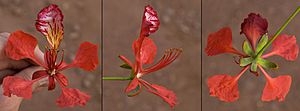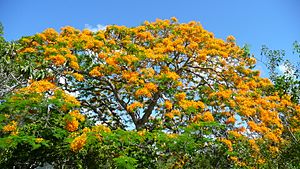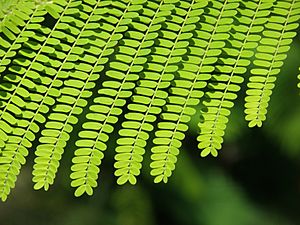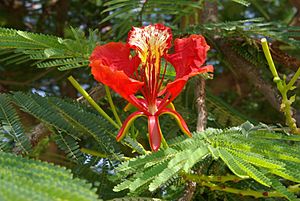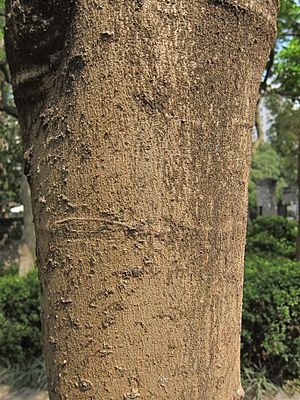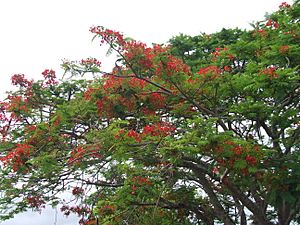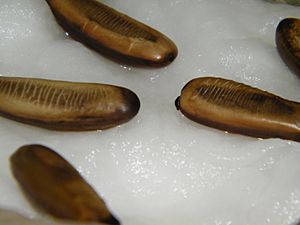Delonix regia facts for kids
Quick facts for kids Delonix regia |
|
|---|---|
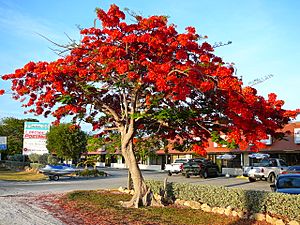 |
|
| Tree in full bloom (Florida Keys) | |
| Conservation status | |
| Scientific classification | |
| Genus: |
Delonix
|
| Species: |
regia
|
| Synonyms | |
|
|
The Royal Poinciana (scientific name: Delonix regia) is a beautiful flowering plant known for its bright, fiery orange-red flowers. It belongs to the bean family, Fabaceae. This amazing tree originally comes from Madagascar, an island off the coast of Africa.
People love the Royal Poinciana because of its fern-like leaves and its stunning flowers that bloom during summer. You can find it growing as an ornamental tree in many warm, tropical parts of the world. It has several common names, like flamboyant, flame of the forest, or simply flame tree.
This tree was once called Poinciana, named after Phillippe de Longvilliers de Poincy. He was a governor in the 1600s.
Contents
What Does the Royal Poinciana Look Like?
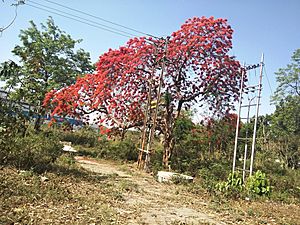
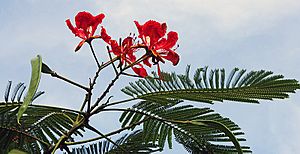
The flowers of the Royal Poinciana are quite large. They have four petals that spread out and are usually bright scarlet or orange-red. These petals can be up to 8 cm (3 in) long. There's also a fifth petal, called the "standard," which stands upright. This standard petal is a bit bigger and has yellow and white spots. The flowers grow in clusters at the ends of the branches.
There's a natural type of Royal Poinciana called flavida that has yellow flowers. Its Bengali name is Radhachura.
The seed pods start green and soft. As they get older, they turn dark brown and become woody. These pods can grow very long, up to 60 cm (24 in). The seeds inside are small.
The leaves of the Royal Poinciana look like ferns. They are light, bright green and have a feathery look. Each leaf can be 30–50 cm (12–20 in) long. They have many smaller leaflets, giving them their unique appearance.
Where Do Royal Poinciana Trees Grow?
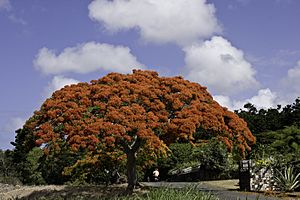
The Royal Poinciana originally comes from the dry forests of Madagascar. However, people have planted it all over the world in tropical and subtropical areas. In the wild, it is an endangered plant. But because it's so widely planted, you can find it growing naturally in many places.
North America
In the United States, it grows in South Florida, Central Florida, and the Rio Grande Valley in South Texas.
Caribbean and Central America
You can see this tree in many paintings from the Dominican Republic and Puerto Rico. It also grows in Belize, The Bahamas, Cuba, Haiti, Nicaragua, the U.S. Virgin Islands, Cayman Islands, Jamaica, and Curaçao. It is the national flower of Saint Kitts and Nevis. You can also find it in Bermuda, Hawaii, and Mexico, especially in the Yucatán Peninsula. The town of Peñuelas, Puerto Rico, is even called "The Valley of the Poinciana Trees" because so many grow there.
South America
It grows in Paraguay, Peru, and all across Brazil.
Europe and the Middle East
Royal Poinciana trees are planted in Mediterranean parts of Europe, the Middle East, and North Africa. This includes the southern coast of Spain, the Valencian coast, the Canary Islands, Lebanon, Egypt, Israel, and Jordan.
South Asia
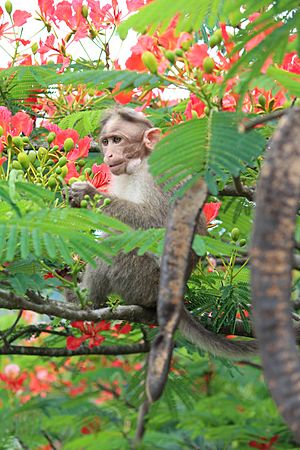
The tree is planted in India, where it is often called the May-flower tree or Gulmohar. In Sri Lanka, it's known as the Maara tree. It also grows in Karachi, Pakistan. In Mauritius and La Réunion, its blooming signals the start of the new year.
Southeast Asia
In Myanmar, it's called Sein-pann-ni. It blooms in March in the south and April in the north. It's a common tree in gardens and along roads. In Myanmar, its bloom marks the Thingyan Festival (April 13–16/17). In the Philippines, its flowering means the monsoon rains are coming soon. It also grows in Thailand, Indonesia, and Vietnam.
East Asia
It grows in Southern China, like Hong Kong. It is the official tree of Tainan, Taiwan; Xiamen, Fujian Province; and Shantou, Canton Province, China. National Cheng Kung University in Tainan even has the Royal Poinciana on its emblem.
Australia
It is very widely grown in Northern Australia. It is also a popular street tree in the suburbs of Brisbane, Queensland. Now, it successfully grows and blooms in Sydney and other parts of New South Wales.
Micronesia
It grows in Guam and is the official tree of the Northern Mariana Islands.
How to Grow Royal Poinciana Trees
What Conditions Do They Need?
The Royal Poinciana needs a tropical or almost tropical climate. It can handle dry weather and even salty conditions. It grows best in sandy or loamy soil that drains well and has good nutrients. The tree doesn't like heavy clay soils. It also flowers more if the soil is kept a little dry.
How to Plant Them
From Seeds
Most Royal Poinciana trees are grown from seeds. First, you collect the seeds. Then, you soak them in warm water for at least 24 hours. After soaking, plant them in warm, moist soil in a spot that gets some shade and is protected. Instead of soaking, you can also gently "nick" or "pinch" the tough outer shell of the seed with small scissors or a nail clipper before planting. Both methods help water get into the seed, which makes it sprout. The young plants grow very fast. They can reach 30 cm (12 in) in just a few weeks if conditions are right.
From Cuttings
Another way to grow them is from cuttings, though it's less common. You can cut branches that are from the current or last growing season into 30 cm (12 in) pieces. Then, plant these pieces in a moist potting mix. This method is slower than growing from seeds, as cuttings take a few months to grow roots. However, using cuttings is the best way to make sure the new tree is exactly like the parent tree. This is especially true for the rarer yellow-flowering type of the tree.
Why Are They Useful?
Besides being beautiful, the Royal Poinciana is a great shade tree in hot climates. It usually grows to a medium height, about 5 m or 15 ft, but can reach up to 12 m or 40 ft. Its branches spread wide, and its thick leaves provide lots of shade. In places with a very dry season, the tree might lose its leaves. But in other areas, it stays green almost all year.
When Do Royal Poinciana Trees Bloom?
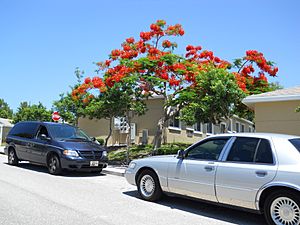
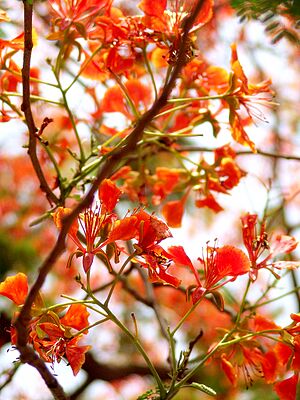
The Royal Poinciana blooms at different times depending on where it is in the world. Here are some examples:
- Australia: November–February
- Bangladesh: April–May
- Bermuda: May–August
- Brazil: October–February
- Canary Islands: May–September
- Caribbean: May–September
- Dominican Republic: July–September
- Egypt: May–June
- South Florida: May–June
- Hawaii: May–June
- Hong Kong: May–June
- Indian subcontinent: April–July
- Israel: May–June
- Lebanon: June–August
- Malaysia: November–December
- Mauritius: November–December
- Pakistan: April–May
- Philippines: April–June
- Reunion Island: November–January
-
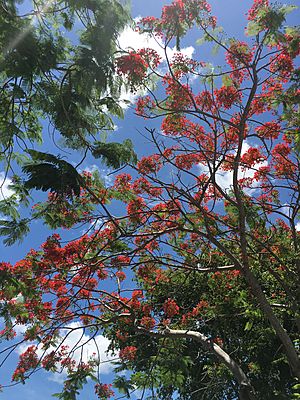 Flowering branches in Pembroke Pines, Florida.
Flowering branches in Pembroke Pines, Florida. - South Texas: May–June
- Thailand: April–May
- United Arab Emirates: May–July
- Vietnam: May–July
Cultural Importance
In the Indian state of Kerala, the Royal Poinciana is called kaalvarippoo, which means "the flower of Calvary". Many Saint Thomas Christians in Kerala believe that when Jesus was crucified, a small Royal Poinciana tree was nearby. They believe that Jesus's blood fell on the flowers, which is why they are bright red. It is also known as Vaaga in some parts of Kerala.
The Royal Poinciana's blossom is the national flower of Saint Kitts and Nevis. In May 2018, the city of Key West in Florida chose the Royal Poinciana as its official tree. In Malaysia, it is known as semarak api and is the city flower of Sepang District.
In Vietnam, this tree is called Phượng vỹ, meaning "phoenix's tail". It is a popular tree in Vietnamese cities. Its blooming season, from May to July, happens at the end of the school year. Because of this, the flower is sometimes called the "pupil's flower". Many schools in Vietnam used to have these trees. However, after some trees fell on students, schools started cutting them down or trimming them very short to be safe. The city of Haiphong is even nicknamed "City of red poinciana" because of these trees.
The famous song "Poinciana" was inspired by these trees growing in Cuba.
- ARKive – images and movies of the flame tree (Delonix regia)
- Dressler, S.; Schmidt, M.; Zizka, G. (2014). "Delonix regia". African plants – a Photo Guide. Frankfurt/Main: Forschungsinstitut Senckenberg. http://www.africanplants.senckenberg.de/root/index.php?submitForm=true&page_id=77&searchTextMenue=Delonix+regia&filterRegionIDs%5B%5D=6&filterRegionIDs%5B%5D=1&filterRegionIDs%5B%5D=2&filterRegionIDs%5B%5D=3&filterRegionIDs%5B%5D=5.
Images for kids
-
Royal Poinciana in New Borg El Arab, Egypt.
See also
 In Spanish: Delonix regia para niños
In Spanish: Delonix regia para niños



